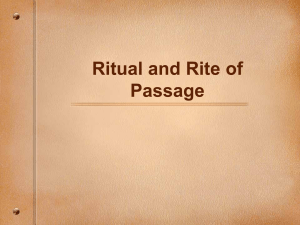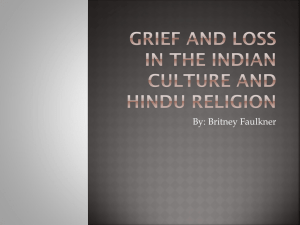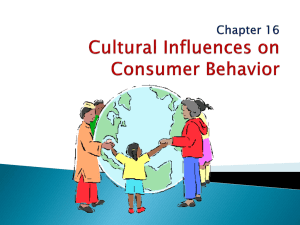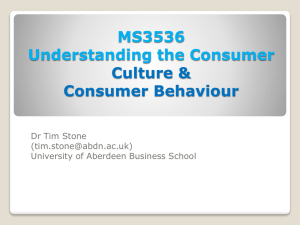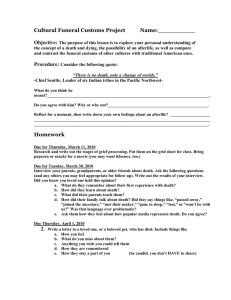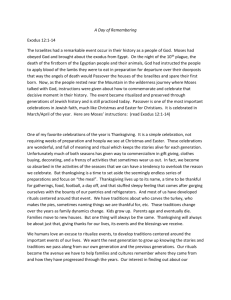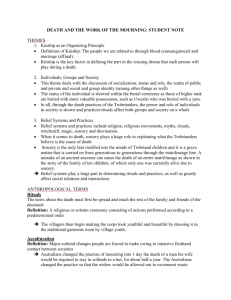Ritual Activities RITE It is a religious performance such as sacrifice
advertisement
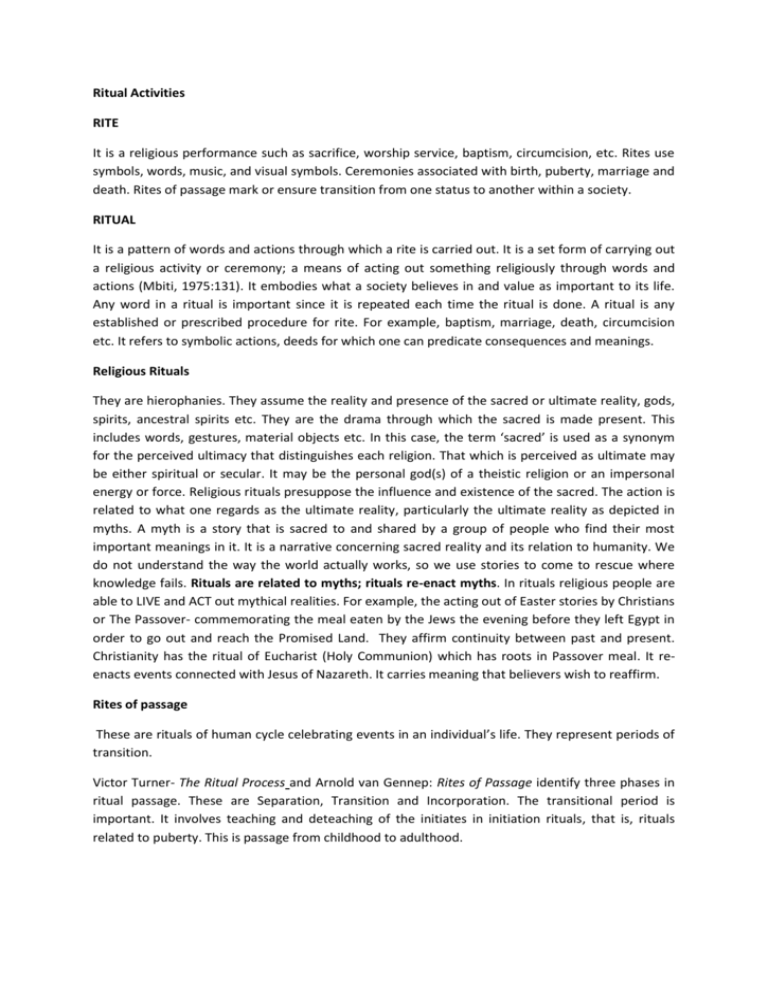
Ritual Activities RITE It is a religious performance such as sacrifice, worship service, baptism, circumcision, etc. Rites use symbols, words, music, and visual symbols. Ceremonies associated with birth, puberty, marriage and death. Rites of passage mark or ensure transition from one status to another within a society. RITUAL It is a pattern of words and actions through which a rite is carried out. It is a set form of carrying out a religious activity or ceremony; a means of acting out something religiously through words and actions (Mbiti, 1975:131). It embodies what a society believes in and value as important to its life. Any word in a ritual is important since it is repeated each time the ritual is done. A ritual is any established or prescribed procedure for rite. For example, baptism, marriage, death, circumcision etc. It refers to symbolic actions, deeds for which one can predicate consequences and meanings. Religious Rituals They are hierophanies. They assume the reality and presence of the sacred or ultimate reality, gods, spirits, ancestral spirits etc. They are the drama through which the sacred is made present. This includes words, gestures, material objects etc. In this case, the term ‘sacred’ is used as a synonym for the perceived ultimacy that distinguishes each religion. That which is perceived as ultimate may be either spiritual or secular. It may be the personal god(s) of a theistic religion or an impersonal energy or force. Religious rituals presuppose the influence and existence of the sacred. The action is related to what one regards as the ultimate reality, particularly the ultimate reality as depicted in myths. A myth is a story that is sacred to and shared by a group of people who find their most important meanings in it. It is a narrative concerning sacred reality and its relation to humanity. We do not understand the way the world actually works, so we use stories to come to rescue where knowledge fails. Rituals are related to myths; rituals re-enact myths. In rituals religious people are able to LIVE and ACT out mythical realities. For example, the acting out of Easter stories by Christians or The Passover- commemorating the meal eaten by the Jews the evening before they left Egypt in order to go out and reach the Promised Land. They affirm continuity between past and present. Christianity has the ritual of Eucharist (Holy Communion) which has roots in Passover meal. It reenacts events connected with Jesus of Nazareth. It carries meaning that believers wish to reaffirm. Rites of passage These are rituals of human cycle celebrating events in an individual’s life. They represent periods of transition. Victor Turner- The Ritual Process and Arnold van Gennep: Rites of Passage identify three phases in ritual passage. These are Separation, Transition and Incorporation. The transitional period is important. It involves teaching and deteaching of the initiates in initiation rituals, that is, rituals related to puberty. This is passage from childhood to adulthood. Types and Functions of Rituals Rituals of life cycle/Transitional Rituals (Personal Rituals) These are rituals performed to bridge the transition in life such as at birth, adolescence, marriage and death. It is especially at times of crisis when the necessities of life, physical or spiritual, demand supernatural intervention that the individual or group endeavours to establish ritual relations with the sacred order to safeguard or consecrate birth, adolescence, marriage and death. i. Birth Rites African peoples are very much concerned about, and concentrate their attention on, life’s journey from before birth to after death. They want that journey to be meaningful, happy, safe and satisfactory. African religion tries to make the journey of life worthwhile for both the individual and the community of which he is an integral part. Prenatal rituals are conducted for a pregnant woman to ensure the growth of the foetus and subsequently, safe delivery. The pregnant woman has to observe certain regulations and taboos in order that all may go well with her and the baby. In some societies she stops sleeping with her husband until several months after delivery or even until after weaning the child. In some areas she is not allowed to do certain types of work such as cutting firewood, using knives, drawing water etc. She eats prescribed food stuff and prohibited from others such as meat from animals from poisoned arrows, salt and certain fats. It is a common practice for the expectant mother to wear charms which are believed to protect her and the baby from harm. Should the expectant mother begin to have pregnancy complications the medicine men or diviner is consulted to find out the cause and take the necessary measures to cure the trouble or prevent it from recurring When the baby has been born, the placenta is, in some societies, thrown into some running stream or dried up and kept for later rituals (Uganda). In other societies it is buried nearby or in the bush. It is looked at as a link between the baby and the mother. As a result, its disposal is accompanied rituals in many places. Childbirth is held to be an impurity in some sense. After childbirth the mother and the child are subjected to rituals because they are undergoing the same process of initiation into the society after some isolation for the mother and the child will be undergoing the initial rite of passage into this life. The mother also undertakes some ritual purification that prepares her for the birth of the next child. The child wears some charms believed to protect it from supernatural dangers. Other rituals are performed to give protection to the baby as it begins long journey in life, to bring good fortune to it and to commit it to the spirit world. The baby’s hair is cut at the occasion of introducing it to the society. This is a sign of purification, separation and newness; anything bad is cut off since it is shaved away with the old hairs. It also shows that it is now separated from the mother and is now belongs to the whole family and the whole community. The shaving is a sign of newness since the baby will grow new hair as it enters a new phase of life. Symbolic washing also accompanies the ceremony, emphasizing purification. The naming ritual is attended by members of the family, relatives, neighbours and friends. The name is considered to be very much part of the personality of the person. It is therefore chosen with care and consideration. Names of people have a meaning and it is this meaning which should be given consideration. It is a period that establishes a communion with the transcendent order. It is the period of dedication of the baby to the spirit world. In some places the baby is given the name of a departed relative whom the baby is considered to resemble closely underwriting the notion of reincarnation. ii. The Initiation Rites / Pubertal rituals (Childhood to adulthood) This marks the attainment of adulthood from adolescence marked by solemn induction into the full privileges and responsibilities of the community that includes religious, social and administrative ones. This involves a process of rebirth or transition from the family circle to active membership in the tribal fellowship. One of the main initiation rites is that of circumcision for boys and clitoridectomy (cutting of a portion of the girl’s female organ) for girls. Without circumcision the person is considered to be a child, no matter how old he or she might be. I t is also shameful to be isolated from one’s age-mates through lack of this experience. Childish things have to be put away by a series of separation rites which usually includes fasting, tests of endurance, perseverance courage and obedience. This education experience equips them mentally, bodily, emotionally and morally for adolescence and adulthood. The proceedings are strictly secretive and during the ceremonies detailed explanations are usually given of the esoteric tradition as well as long exhortations on correct social behaviour and religious practice. To reveal to the uninitiated anything said and done in the course of the mysteries involves instant death by natural or supernatural agencies. Meaning- The blood which is shed during the operation binds the person to the land and the departed members of their society (a mark of identity). It shows that the individual is alive and that they now wish to be tied to the community and people among whom they have been born. Until the operation is done they are still considered to be outsiders. It is a public recognition that the individual is now passing from childhood to adulthood. The cutting of the flesh is a symbol of getting rid of childhood and getting ready for the adulthood. No full responsibilities in the home and community are conferred on the uninitiated for they are still considered children. Initiation is also a gateway to marriage. In the period of seclusion they are taught many things concerning the life of their people, its history, traditions and beliefs and to raise a family. It is the initiation which also bridges the male with the female, fatherhood with motherhood since it signals the official permission for one to get married and bear children. It also joins the living with the departed the visible with the invisible for a person may perform religious rituals only after initiation. Where circumcision is not practised, there are other forms of initiation. This may be done on family basis or by the community at large. This may involve, for example, brewing some beer and slaughtering a goat for the older men, who then ceremoniously welcome the young adolescents to their status (J.S, Mbiti, 1975:103. iii. Marriage / Betrothal Rituals Circumcision and clitoridectomy, where they are practised, have a practical as well as a magicoreligious significance. They symbolically represent the flow of life through the shedding of blood from the organs or reproduction. This is a profound act by means of which the young people accept that they have to become bearers of children. Initiation ia a preparation for marriage. Marriage, in this regard, is viewed as a sacred duty which every normal person must perform. Failure to do so means stopping the flow of life through the individual resulting in the diminishing of mankind upon the earth. Those who seek to evade the duty commit a major offence against society and people will be against them. Some rituals are done to combat the evil spirits suspected of standing in the way of the evader (‘kupisira mudumba’ among the Ndau). Marriage is the meeting point for the three layers of human life in African Religion: these are the departed, the living and those to be born. The departed are the roots on whom the living stand. The living are the link between death and life and the unborn are the buds in the loins of the living and marriage ensures their germination. Failure to get married means that one is cutting off the vital link between death and life. Through marriage the effects of death are reduced and neutralized. Marriage and childbearing are medicine against death. It is the only means of human survival and that being the case, marriage is a religious obligation. It is at the very centre of human of human existence. It is the custom in some areas for the wife or both wife and husband to be secluded for several days after the initial wedding. The seclusion in the house, followed by exposure to the public afterwards, is a symbolic way of showing that the couple is being born into a new life; that they are coming out of the womb (of the house). Their ‘birth’ into married status is greeted with jubilation. Rituals and ceremonies accompany or follow the occasion of the wedding. The aim is to pray for welfare of the new couple, to bless them so that they will bear children and to give them instructions and rules on how to conduct themselves as married people. At these rituals the living dead of the family are called upon to witness the occasion and to give their blessings to the new husband and wife. iv. Death Rituals Death is sorrowful and is also important. There are many rituals and ceremonies associated with death. People are very much sensitive to what is done when there is death in the family. It marks a physical separation of the individual from the other human beings. Funeral rites and ceremonies are intended to draw attention to that separation and to avoid causing offence to the deceased. This is not done to unknown strangers, thieves, murderers, witches and other troublemakers in the community, or for those who have died abnormal deaths. Disposal of body There are rituals concerning the preparation of the corpse for disposal. It is washed with water or with water and traditional medicines. In other areas it is shaved and the nails are cut off. Skins, leather, cotton, clothes or leaves are used to cover the corpse and the whole body is covered with oil in some places. Ritual leaders and elders in the village preside over these rituals. In some places some individuals are not allowed to touch or come near the corpse in case misfortune will befall them or their family. These are usually the children, pregnant women or suspected witches. Burial takes place in the backyard of one of the houses in the village, in a family burial place or at the original place of birth. It is the custom in many parts of Africa to bury some belongings with the body, such as spears, bows and arrows, stools, snuff, foodstuffs, beads, ornaments, money, tools and domestic utensils. In some instances wives and servants, for the rich were also buried with the dead. The belief was that the departed needs weapons to defend himself along the way to the next world and food to eat on the journey and people to keep him company when he reaches there and other property to use so that he would not arrive there empty-handed. Various rites are performed at the burial of the body. They are intended to send off the departed peacefully, to sever his links with the living and to ensure that normal life continues among the survivors. Feasting follows the funeral rites. This is meant to comfort the bereaved and to bring life back to normal and thank those who have officiated in the funeral rites. It is also the custom to stop work for a while as a sign of respect for the dead person. In many places members of the family have their hair shaved off and some of their normal activities are suspended until all the funeral rites have been performed. The shaving of the hair is a symbol of separation, showing that one of the family has been separated from them. It is also an indication of people’s belief that death does not destroy life, since the growth of the new hair indicates that life continues to spring up. In some places people smear themselves with white clay as a sign of death and mourning, in others they refrain from washing their bodies and clothes for several days or months. Certain bulls or goats may be killed to mark the death of someone. Sometimes people suspend sleeping with their marriage partners for some weeks, pots are broken up in the houses and certain houses in the homestead are abandoned for good as an indication that someone has died. By doing these things people are able to come to terms with the agonies, sorrows, and disruption caused by death. By ritualizing death people dance it away, drive it away and renew their own life after it has taken away one of their members. Death rituals are also meant to make the deceased members of the family to safely enter into the spirit world and look after the living (kurova guva ceremony) Installation/coronation Ritual These are rituals meant to elevate individuals to high positions/posts. They are done for chiefs Crisis Rituals/Impromptu Rituals These are rituals intended to rectify misfortune such as barrenness, illness, war etc which are believed to disrupt the social order. They renew the people’s lives, bringing the picture of the sacred to life. For example, rainmaking ceremony is conducted in the event of drought. There are also rituals to deliver a person from evil spirits. There are also rituals intended to ensure success in battle, hunting and academic sphere. There are also rituals conducted to appease/ compensate avenging spirits. They are done to ameliorate the problem and restore harmony on the cosmos. Agricultural rituals and Health rituals are some of the rituals undertaken to ensure harmony in those spheres.
